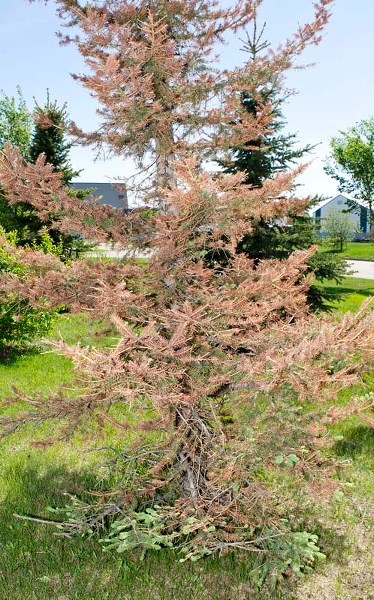A host of problems, including bugs, bad roots and a harsh winter are behind a recent rash of spruce and pine deaths in St. Albert, say local experts.
Several residents contacted the Gazette in recent weeks asking about an apparent spike in white spruce and pine tree deaths.
While tree stands are not dying en masse, said local environmentalist Elke Blodgett, dead ones are turning up all over town. Hot spots included the Enjoy Centre, St. Albert Place and Villeneuve Road near Walmart. “All over the place, the evergreens are dying.”
White spruce, Colorado blue spruce and pine appear to be the main trees affected, Blodgett said. Many of these trees had been in trouble for years, but there was a definite jump in mortality this spring. “All of a sudden this year, mass destruction.”
Many were also near high-idling locations such as bus stops and turning lanes, Blodgett said, which led her to suspect air pollution. “Whenever there are cars parking, the exhaust has killed the trees.”
While air pollution could be a contributor to these tree deaths, said Warren Kindzierski, a professor of environmental health sciences and air quality researcher at the University of Alberta, it wasn't likely to be the main culprit – you usually need an intense, short-term blast of air pollution before you get plant deaths, which you're unlikely to get at high-idling locations.
Local air quality specialist David Spink agreed, noting that car emissions could actually enhance plant growth through nitrogen (a fertilizer) deposition. A key indicator will be tree lichens. “If you are seeing a healthy lichen population, then it would indicate that factors other than air pollution are responsible for tree mortality.”
Sheila Flint, the urban forester for Strathcona County, said she had received many similar reports of spruce and pine deaths this year in Sherwood Park, particularly in the last two to three weeks.
Her research suggests that the recent harsh winter was the main culprit. “We went into the fall without a lot of moisture in the ground,” she said, which would have stressed evergreens, as they keep breathing all winter. The long winter plus high winds would have desiccated these trees, causing them to die in the spring. “We are losing a lot of spruce.”
Many trees were also stressed by the last 10 to 15 years of drought, Flint continued, which was followed by floods. With their roots weakened, some trees couldn't take the pressure.
Trees in northern St. Albert had been assailed by the yellow-headed spring sawfly, pine scale and the root collar weevil, said St. Albert city arborist Kevin Veenstra. Others may have been affected by the large amount of road salt used this winter.
Some weren't planted properly, said the Enjoy Centre's Jim Hole, who examined several local trees at the Gazette's request. “Trees grow in pots typically, and roots start wrapping around the pot.” If this isn't addressed prior to planting, the roots can strangle a tree like a snake – a problem he'd seen in many local trees. “It's a bit of an epidemic.”
The trees around the Enjoy Centre and St. Albert Place were also victims of bad planting, Hole continued. The ones by the Enjoy Centre were planted too deep, he said, which is why they died so fast.
Some of the old trees by St. Albert Place had dirt piled around their trunk, which was another no-no. “Nothing should ever go up against the trunk,” Hole said. “The soil fungi, they're very patient, and they just sit there and they chew away at that trunk,” he said, eventually killing the tree.
Trees planted by roads may have had their roots restrained by pavement, said Peter Murphy, a retired St. Albert forestry professor who also checked out some of the city's afflicted trees.
“I don't think there's any one cause,” he said. While climatic conditions may have weakened these trees, many other factors may have finished them off. “They may have been dead last fall.” It would be tough to say for sure without doing an autopsy.
The trees that aren't dead are doing remarkably well, Murphy said. “We live in a climate that's harsh and variable. Some (trees) are going to survive and some are not.”
Anyone with concerns about a public tree should call public works at 780-459-1557.




